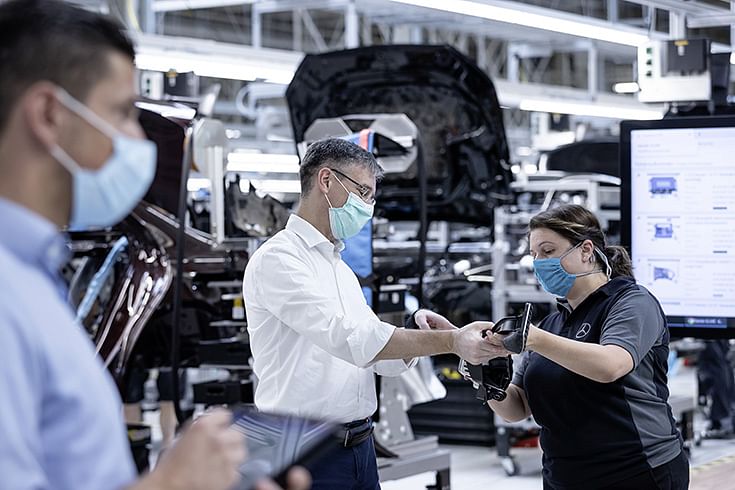5G to help accelerate drive to digital factories in India
With machine-to-machine communication becoming faster on a private 5G network within an enterprise, the latest connectivity technology is set to give a fillip to smart manufacturing.
On December 15, 2022, Mahindra & Mahindra (M&M) announced that its Chakan plant has become India’s first 5G-enabled automobile manufacturing facility by latching on a private network provided by Bharti Airtel.
The homegrown automaker of popular SUVs like the Mahindra Thar, Scorpio and XUV700 said that it will leverage this high-speed connectivity to speed up critical processes such as undertaking multiple software flashing sessions on cars simultaneously at the assembly line before they are rolled off, and deploying computerised vision-based inspection systems inside the paint shop.
The above two use cases are just some of the examples how the latest high-speed connectivity technology from the telecom industry is set to benefit the automotive ecosystem – its machines, supply chain, quality-oriented processes, as well as autonomous driving.
According to Dr Rishi Bhatnagar, president, Aeris Communications, “For the first time, the government of India has allowed setting up a private network with 5G connectivity and this will enable enterprises to independently establish their own networks for machine-to-machine communication within a factory environment.”
“Within the factory, companies can create their own 5G networks and this will give a strong push to digital factories or future factories,” he said.
Dr Bhatnagar, who heads the Indian arm of the US-based IoT connectivity solutions company, further explained that more than humans, 5G is going to be relevant for machines, as it offers more accuracy, reliability as well as higher speeds to enable machines stationed in critical operations in manufacturing and healthcare industries to offer high-quality output.
“5G will be required when you have remote operations and the accuracy of connectivity is a must. So far, there have been various high-on-robotics automotive plants in India but they are more of a showcase,” he mentioned.
“With 5G and the ready availability of this connectivity technology, OEMs will now be able to create a private 5G network within their complex, utilise the low-latency machine communication technology and ensure quality standards that meet the norms of global markets,” Dr Bhatnagar said.
 At Mercedes-Benz’s Factory 56, the high-performance WLAN and 5G mobile network provides an important basis for full digitisation. It uses ultra-modern Industry 4.0 applications – from smart devices right up to big data algorithms. Digital production technologies have been implemented everywhere. Furthermore, Factory 56 is completely paperless.
At Mercedes-Benz’s Factory 56, the high-performance WLAN and 5G mobile network provides an important basis for full digitisation. It uses ultra-modern Industry 4.0 applications – from smart devices right up to big data algorithms. Digital production technologies have been implemented everywhere. Furthermore, Factory 56 is completely paperless.
5G adoption to depend on its application
While the general public will also realise the benefits of 5G connectivity with ultra-fast internet speeds on their personal devices, the telematics functions inside cars are still going to take a little more time as the cost of upgrading the existing 2G, 3G or 4G modules to 5G will be expensive in the initial leg until the technology is localised in India to a greater extent.
“Changing the module is going to be an expensive affair and changing the entire future architecture of the vehicle will depend on the specific application of the 5G technology,” Dr Bhatnagar said.
“However, there’s a huge commitment from the government to facilitate local manufacturing of these high-end electronic components in India with the PLI schemes,” he added.
Citing an example, Dr Bhatnagar explained that if extremely-high accuracy is not the requirement, like in case of a vehicle being geofenced with a scope of error of up to 20 metres in its location pin, it would not make a viable proposition for OEMs to switch to 5G immediately.
“The bigger push, however, is bound to come on the industrial front, wherein the foray of 5G will enable a greater adoption and implementation of smart manufacturing or Industry 4.0 technologies,” he said.
5G as an autonomous driving enabler
The next big use case of 5G connectivity in the automotive ecosystem is going to be autonomous driving wherein the low-latency data network will enable this future-oriented, developing innovation to take the shape of reality. Level 3, Level 4 and full-autonomous driving are going to see the light of day in the future with the continuous advancements in connectivity technologies.
“It is imperative for an autonomous vehicle which is driving through the highways on its own to have a very reliable data network, with minimal latency. Going forward, 5G can enable operations of autonomous trucks on dedicated freight corridors even in India,” he signed off.
This feature was first published in Autocar Professional's January 1, 2023 issue.
RELATED ARTICLES
From Rs 431 Crore Loss to Recovery: Inside TIL’s Comeback
New ownership charts ambitious turnaround for TIL, India's oldest crane manufacturer.
Why Toyota Is Building Its Carbon-Neutral Future Around India
A look inside the engineering logic driving the world’s largest carmaker as it pursues multiple routes to decarbonisatio...
ZF’s Construction Equipment Strategy Reveals How India Has Moved Beyond the Auto Market
ZF's leadership sees the construction equipment sector as an anomaly, a segment that, despite its current sluggishness, ...






 21 Dec 2022
21 Dec 2022
 8140 Views
8140 Views














 Shahkar Abidi
Shahkar Abidi


 Ketan Thakkar
Ketan Thakkar


